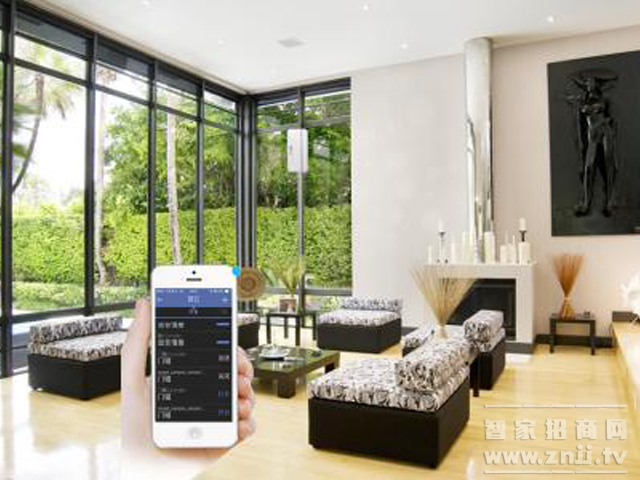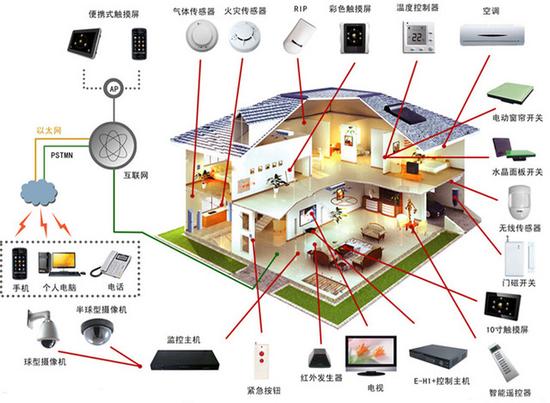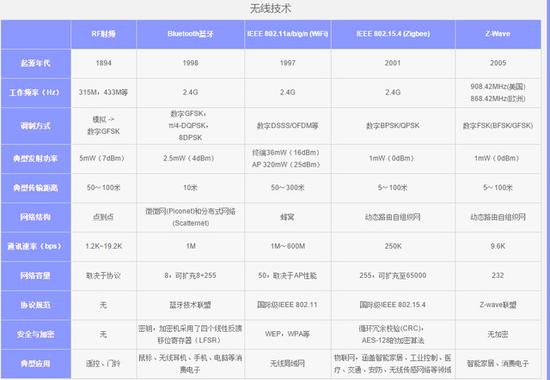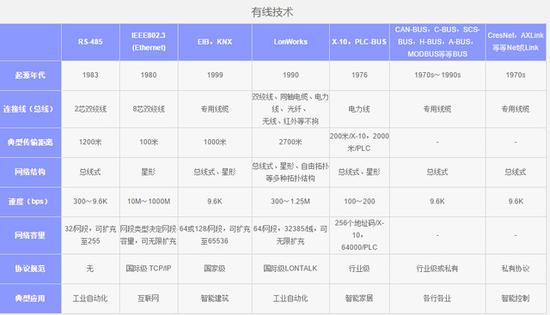Not simple! Detailed smart home systems
The reference rate of smart homes now on the Internet is quite high. It seems that smart homes have entered our daily lives. Everyone has come into contact with smart homes. For example, if you buy a smart light bulb, you think that your home has achieved intelligent lighting; installing a fingerprint lock is smart security; using a WIFI speaker, you think your home has a background music system. However, in reality, smart homes are still far away from us, and they are much more complicated than we think.

Smart home, or smart home, is a residential, as a platform, combining construction equipment, network communications, information appliances and equipment automation, efficient, comfortable, safe, convenient, environmentally friendly living environment integrating system, structure, service, and management. . On the basis of maintaining traditional living functions, it has been freed from the passive mode and has become a modern tool with dynamic intelligence. Therefore, smart home is a wide range of system products, not a single independent individual product. It includes home wiring system, home network system, smart home (central) control management system, home lighting control system, home security system, background music. System, home theater and multimedia systems, home environment control systems and other eight systems. Among them, smart home (central) control management system, home lighting control system, home security system is an essential system, home wiring system, home network system, background music system, home theater and multimedia systems, home environment control system is an optional system .
In the identification of smart home environment, only smart homes that have completely installed all necessary systems and have at least one or more optional systems installed can be called smart homes.
Is there some big heads? The complete smart home system is currently a local-oriented system. The smart home appliances that we use are just “seeing the leopard†and try out the convenience of smart products. 
What exactly do so many systems represent? We will briefly introduce them.
Home wiring system : Through a total management box, telephone lines, cable television lines, broadband network lines, audio lines, etc., which are called weak currents, are all planned in an orderly manner to manage the telephones in the house. Fax, computer, television, video player, security monitoring equipment and other network information appliances make it more powerful, easier to use, easier to maintain, and easier to expand new applications. Implementation of telephone extensions, LAN formation, cable TV sharing.
Home network system: In the office, in the field where you are on a business trip, as long as there is a network, you can log in to your home through the Internet and control your home appliances through a fixed smart home control interface in the online world. Provide a free dynamic domain name. It is mainly used for remote network control and electrical status information inquiry. For example, if you are traveling in a foreign country, use a foreign network computer, and log in to the relevant IP address, you can control your own home lighting, electrical appliances, and return home. Before the plane, turn on the air conditioner or heater in your home.
Smart home (central) control management system: that can control all smart home control systems, reduce costs and maximize functionality, from a practical point of view so that many functions to achieve as simple and effective control as possible, enabling users to only integrate smart home system Within the product, six functions of light control, electrical control, security alarm, background music, video sharing and weak information can be achieved.
Home lighting control system: to achieve intelligent management of the whole house lighting, you can use remote control and other intelligent control methods to achieve the whole house lighting remote control switch, dimming, full-on off and "conference, theater" and other one The realization of the key lighting scene effects; and can be used timing control, telephone remote control, computer local and Internet remote control and other control methods to achieve the functions, so as to achieve intelligent lighting energy saving, environmental protection, comfort, and convenient functions.
Home Security System: The video surveillance function can use the browser (such as IE) to perform remote image monitoring and voice calls directly at any time and any place through the local area network or broadband network. In addition, it also supports remote PC, local SD card storage, motion detection mail transmission, FTP transmission, for home use remote video shooting and taking pictures can achieve professional security protection and fun.
Background music system: Family background music is a new background music system developed based on the basic principles of public background music combined with the characteristics of family life. Simply put, in any home in a house, such as a garden, living room, bedroom, bar, kitchen or bathroom, MP3, FM, DVD, computer and other audio sources can be systematically combined so that each room can hear With wonderful background music, the music system can beautify the space and play a good decorative role.
Home theater and multimedia system: It refers to adding the smart home control function on the basis of the traditional home theater, intelligently and completely controlling all the audio and video equipments in the home theater room and the theater environment equipment intelligently and completely to create more comfortable, more convenient, and more. Intelligent home theater audio-visual and entertainment environment to achieve the best viewing, listening to music, video game entertainment effects.
Home environment control system: The latest home environment monitoring equipment can detect environmental data including formaldehyde, PM2.5, humidity, temperature, etc., and can be linked with scene combinations. It can be used in conjunction with multi-function carbon dioxide detectors to automatically adjust the indoor air quality to solve the problem of low air quality brought about by ordinary residential cooling and heating air circulation. It replaces the new system in 24 hours and completely replaces the indoor air. Outdoors, significantly improve air quality.
Through cloud computing, the family will become an open cloud platform. Terminals such as mobile phones, tablet computers, and personal computers can share information in real time and lock in the focus of attention to satisfy users' needs regarding security, comfort, and even social aspects. Cloud computing will make smart homes more powerful.
Smart home communication protocol and standard camp
What we call the smart home standard is actually the language that the devices in the home communicate with each other. If you want to connect them together to form a smart home network, you must let these devices understand what they want to express, so that they can achieve cooperation. At present, international standards in the field of smart homes are not yet mature. Major manufacturers and related organizations are working to establish and formulate network interface standards and data transmission protocols between devices in smart home systems. However, as far as the current situation is concerned, smart home communication protocols The camp is complex and incompatible.
Regarding the communication protocol, there are already many communication protocols in the smart home field. WiFi, Bluetooth, ZigBee, Z-Wave... It is estimated that the developer has a big head when choosing that kind of protocol. Finally, it is likely to be forced to support like Homey. Eight communication protocols. Now, Samsung, Nest, and ARM have jointly launched a new protocol, Thread. It is not known whether Thread will accelerate the formation of uniform standards in the industry, or whether the communication protocol that has already been turbulent enough will be even more "scissors and tangles". 
Now more commonly used network protocols are WiFi, Bluetooth, ZigBee, Z-Wave, but there are insufficient:
1. WiFi's power consumption is relatively large, suitable for the transmission of large amounts of data;
2. The Bluetooth power consumption is relatively low, but there is still confusion between Bluetooth 2.0 and Bluetooth 4.0 coexistence, and does not support IPv6;
3. ZigBee cabling is more complex and more suitable for commercial use;
4. Z-Wave is led by the Danish company Zensys. For the time being, there is no ZigBee alliance. 
These are just wireless protocols. There are also many wired communication protocols.
1.RS485
2. IEEE802.3 (Ethernet)
3. EIB, KNX
4. LonWorks
5. X-10, PLC-BUS
6. CAN-BUS, C-BUS, SCS-BUS, H-BUS...
7. CresNet, AXLink, etc. Net or Link
Compared with communication protocols, the standard camps of various companies are even more complicated.
Google spends a lot of money, and after 3.2 billion US dollars received smart home company NEST, it also acquired surveillance camera company Dropcam for US$555 million; Microsoft waited for the opportunity to start cooperation with home automation technology company Insteon and then launched Microsoft Venture Incubator. Supporting 10 smart home startups; Apple launched Homekit, a smart home platform that integrates hardware. Apple also launched Apple’s first wearable Applewatch at its new product launch in September. Samsung is the smart home hardware and software. Systems, platforms, patents on the one hand.
The first camp companies can also be divided into two subcategories, such as Apple, Google, Jingdong, Ali, Tencent, Baidu, 360 and other companies that build smart home support platforms or operating system platforms and provide sensors, communication modules, chips, and micro-controls. Unit, battery company.
In general, such enterprises do not produce products that are directly oriented to consumers, but rather provide corresponding accessories and capabilities for the overall construction of smart homes. They are at the top of the threshold, especially for apps and cloud platforms. They are actually "burning games." They need to connect enough devices into their own platform before they can hold the end and convert users into other value-added services or values. In order to take advantage of the competitive advantages of the Internet of Things, the Internet giants are now arranging for the future, accumulating a large number of users and accumulating massive amounts of equipment. They do not define business models. Although these Internet companies seem to have not found directions and paths yet, they must do it again because they do not want to lose their future opportunities.
The second camp is a professional smart home system vendor. Generally referred to as smart home system manufacturers or brand manufacturers, these manufacturers provide users with corresponding smart home solutions, provide appropriate design, installation and service for the intelligent home space. IOT Sensing is a typical smart home brand manufacturer. With its comprehensive advantages in object sensing and controllers, IOT Sensing has become the leader in the smart home industry in the Internet of Things era. In addition, IOT Sensing's smart home products have won more and more recognition from users with its good user experience and high cost performance.
The third camp is a start-up team. The startup of small companies in smart homes, especially single products, is quite difficult. The threshold for the first two types of companies is relatively high, and the startup team only finds its own advantages in the development of single products. The team's lack of experience in hardware design and manufacturing processes, production process control, and raw material procurement is more concerned with product functionality. However, as far as the market is concerned, the competition for homogenization of smart single products is quite serious. Startup teams need more integration of resources to grow.
How to choose a smart home system?
Looking at the smart home system is so complicated that if we want to get a set of this system, ordinary consumers must spend a lot of money, but also involve various projects related to the decoration, so how to choose their own smart home products is a can not be ignored Question, then we will give some suggestions to help you choose your smart home system. 
1, clear personalized needs
Before you purchase smart home products, you must be clear about what your needs are and what personalized services you need. Every family has different requirements for smart living, so the purchase of smart homes is different. The functions of the smart home can be arbitrarily combined to meet the needs of different consumers for smart living. In addition to the necessary functions, such as home security systems, alarm systems, intelligent lighting systems, etc., we can also install smart home products according to their special needs, such as home entertainment systems, background music systems, etc. It allows us to Enjoy more entertainment at home.
Some consumers like to pursue perfect functionality and blindly install smart homes. This is actually an unwise choice. Because some functions are unnecessary, they will only become fresh furnishings. This will not only make your smart life greatly reduced, but it will also bring a lot of unnecessary trouble. Therefore, it is recommended that you buy products according to your actual needs and use the least amount of money to realize your most necessary needs.
2, choose energy-saving and environmentally friendly products
Energy conservation and environmental protection have become the key words. Promoting energy conservation has become a trend of consumption and industry trends. All walks of life are also advocating "energy saving" and "environmental protection." As a smart home manufacturer, providing users with both good and energy-saving products, it can not be ignored. Intelligent home control system based on computer technology and automation technology, energy saving and environmental protection functions are most prominent in lighting energy saving, and can achieve lighting energy saving through a variety of core means such as timed event management, sensor control functions, and brightness sensor light brightness automatic detection. .
3, product and brand choice
When selecting a product, the main concern is the quality and appearance of the product. In addition to smart home products that can bring us smart enjoyment, in fact, a good appearance and technology can also bring beautiful visual enjoyment to our family. Some smart home products focus on the function of the product and ignore the visual enjoyment of the appearance, so this also becomes a point that consumers can not ignore in purchasing products. The choice of the brand must follow the principle of “comparing the three productsâ€. Choosing an excellent smart home brand manufacturer is a good way for you to avoid risks. Because a big brand manufacturer, the quality of the product is guaranteed, and the technology can also be guaranteed. Consumers must choose the brands with good reputation and high reputation as far as possible when selecting smart homes. This allows you to feel comfortable buying and using it safely. Of course, when you choose an agent, it is best to use this principle.
4, whether there is a remote control function
Remote control refers to the realization of various remote controls through a remote controller, a timing controller, a centralized controller, or a telephone, a mobile phone, or a computer. A smart home is equivalent to a home smart control center that integrates home appliance control, home security and surveillance, home information terminals, and home digital entertainment. Therefore, when purchasing, please check whether you can access the smart terminal through the Internet and operate the experience.
5, whether the function is integrated
Smart home integration integrates home-life-related equipment using integrated wiring technology, network communication technology, security technology, automatic control technology, and audio and video technology. For home devices, centralized and unified control is used, so the core should be a communication protocol, a system platform, and a solution that is equivalent to the computer's operating system. The corresponding specific products, such as security products, surveillance products, lighting control products, multimedia products, etc., can be integrated in this system, through the system's communication protocol, so that each subsystem is connected to each other, exchange information, operation can be Mutual control. Nowadays, many of the products on the market that only have a simple subsystem equipment product are also advertised as smart homes. This is actually incorrect. This requires consumers to make detailed analysis with the merchant before purchasing, and the compatibility of the products. It must be good.
6, whether the product after-sales service
For each manufacturer, the after-sales service of the product is an important factor in the development of the company. Consumers pay great attention to the quality of after-sales service when buying large consumer goods. Especially when buying smart home products, this is even more important. The smart home market has yet to be standardized in the country, and each company's after-sales service situation is also different. Therefore, consumers must understand this aspect clearly.
Smart home has broad prospects in China and even in the world. Based on the analysis of the current development trend, there will be nearly 2-4 billion households constructing a home network in the future. It can be seen that the profit will be the largest, and the rapid development of the industry is At present, no other domestic industry can match it. Perhaps the emergence of smart home will completely change our lifestyle. The development of smart wearable device hardware is also making the operation of smart homes more and more simple.
The source of this article - Zhijia Network: http://, reprint please leave a link.
Hotel Humidifier
Hotel Humidifier brings the feeling of fresh spring air to your hotel room, especially in winter.
Hotel guests expect that temperature and humidity in their hotel room, in the swimming pool area and the spa to be at a healthy and comfortable level. The right level of relative humidity during the heating season improves the well-being of your guests. A relative humidity between 40 and 60% RH means a comfortable indoor climate.
During the winter heating season, the relative humidity is often below 30%. Low humidity levels affect the well-being and health of your guests. Without humidification, susceptibility to illness and disease is substantially increased.
The reason: aerosols containing viruses remain airborne longer when humidity is low, significantly increasing the risk of transmission, and a dry nose, throat and skin mean the body`s natural resistance is reduced.
DITUO Oil Humidifier are commonly used to increase indoor humidity, or the level of moisture in the air. Primarily used in the winter months, due to indoor heating systems and cold temperatures lead to low humidity levels. The use of a Room Humidifier in these drier months can have numerous health benefits. DITUO Whole House Humidifier help in reducing dry skin and chapped / dry lips during the winter months.
Hotel Humidifier
Oil Humidifier,Hotel Humidifier,Room Humidifier,Whole House Humidifier
Shenzhen Dituo Electronic Co.,Ltd. , https://www.sz-dituo.com